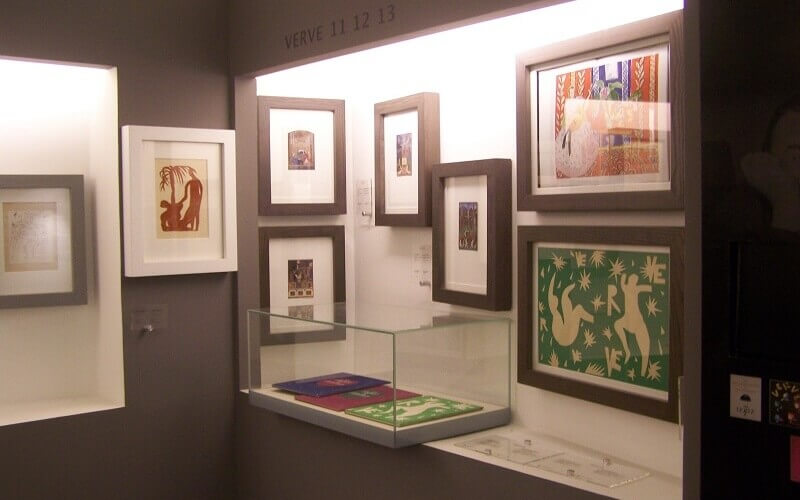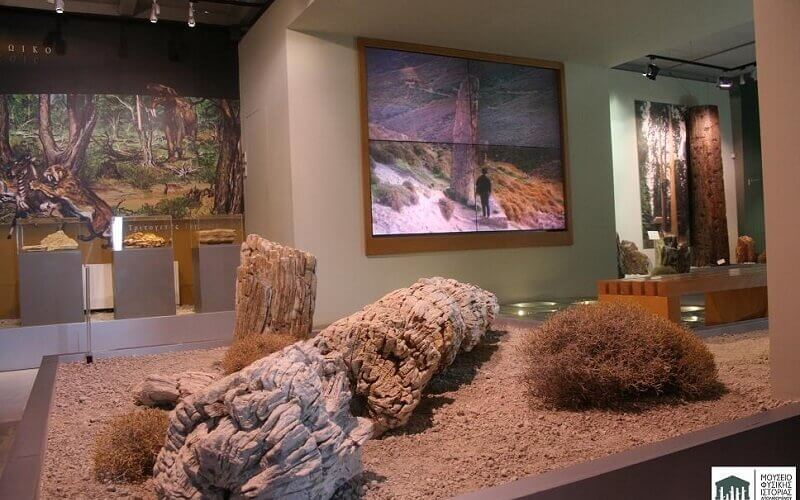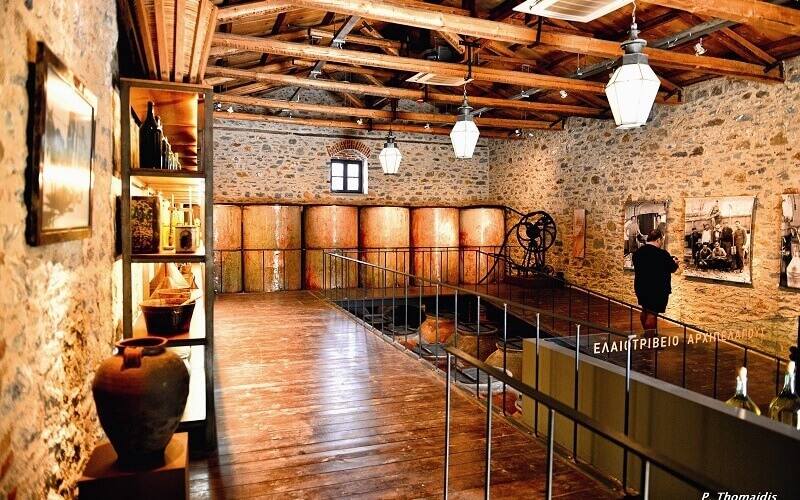The Archaeological Museum of Mytilini is housed in two buildings the New and the Old building. Lesvos’ history from the Final Neolithic period to the Late Roman occupation is presented at the Old building of the Archaeological Museum. It was built in 1912 as a residence of the Vournazos family in the architectural style of eclecticism. On the first floor there are exhibits from the Final Neolithic period (cave of Agios Varhtolomaios) as well as the Bronze age (Thermi) while objects from 10th c. B.C. to 4th c. AD are found on the second floor. Unique Aeolic capitals as well as inscriptions are exhibited at the homestead building. Finally, heavy sculptures and architectural parts of important buildings of Mytilini of the Hellenistic and Roman times are found at the yard of the building. The finds from the excavations of the settlement of the Bronze age spotted at Thermi are at the forefront of the permanent exhibition: clay vessels, stone iron and bone tools, weapons, loom weights and whorls as well as figurines.
The New building was erected according to the modern museological standards. Its construction works were completed in 1995. The exhibition at the New building presents the everyday religious, economic and political life of 3rd c. BC and the 4th c. AD. Mosaic floors of roman villas are exhibited in the three halls of the ground floor, while samples of sculptures (reliefs, portrays, sculptures in the round) of Lesvos were placed at the semi basement. Exhibits related to roman symposia are hosted at the halls of the periodical exhibition. The mosaic floors of a roman villa of 3th c. AD under the common name “Menandros’ Domicile” which was the headquarters of an association of theatre people are very impressive. Educational activities addressed to students of primary and secondary schools, paint exhibitions, lectures and seminars take place at the new building.
The Theophilos Museum was built in 1964 in Varia, a suburb of Mytilene, where the popular artist was born and spent his childhood years. It was built by the famous Mytilenian publisher of art books in Paris, Stratis Eleftheriades (Teriade). In 1965, Teriade donated the Museum to the Municipality of Mytilene, together with 86 of Theophilos’ paintings from his own private collection. Since then, it has been operating as a municipal museum. The building is built in the dusty pink local stone, which harmonizes perfectly with the extensive olive grove around it. It consists of four connecting rooms in which are displayed 86 paintings by Theophilos. Their subjects are inspired from folk art, history and mythology. They also depict everyday scenes, costumes, landscapes, etc.
Opening Hours: Monday to Friday: 08:30-14:30
 The Museum-Library of Stratis Eleftheriadis – Teriade is located in the region of Vareia. It roofs safeguards and presents the entire publishing work of its establisher, Stratis Eleftheriadis- Tériade, this unique, inspired man and artist.
The Museum-Library of Stratis Eleftheriadis – Teriade is located in the region of Vareia. It roofs safeguards and presents the entire publishing work of its establisher, Stratis Eleftheriadis- Tériade, this unique, inspired man and artist.
For the first time, painters such as Matisse, Picasso, Chagall, were given the opportunity not simply to illustrate books, but to create an artisic work through the medium of the book. In the Museum are also exhibited works by: Baudin, Bornard, Bores, Chagall, Giacometti, Grimaire, Laurence, Le Corbusier, Leger, Matisse, Miro, Picasso, as well as by: Giorgos Vakirtzis, Theophilos Hadjimichail, Manolis Kalliyiannis, Orestis Kanellis, Callirhoe Marouda, Giorgos Rorris, Yiannis Tsarouchis. The museum has opened its doors to the public in August 1979. Stratis Eleftheriades-Teriade (1889-1983) was an inspired publisher. From his cooperation with the leading artists of the 20th century, were born the so-called Great Books, which are the most important exhibits of the Museum.
Link: www.museumteriade.gr
The Ecclesiastical Byzantine Museum of Mytilene houses one of the most remarkable collections of Byzantine civilization. It is an institution with content and quality in the field of culture. The history of the museum is not a long one. In 1978 the Museum started to function in a building in the city center, opposite the entrance to the Church of Agios Therapon. Of the works of Christian art to be found in the Museum, a special place is held by the icons, which constitute the most valuable part of the collection. The collection of icons ranges in date between the 13th and 19th centuries. Apart from the main collection of icons, there are collections that consist of other objects of Christian art, such as carved wooden sanctuary doors, vestments, manuscripts, liturgical vessels, Minor Arts collection, etc.
Tel.: +30 22520 32200, 31446
Link: www.ebmm.gr/museum.php
The “Georgios Jakovides” Digital Museum, in Hidira of Lesvos, birthplace of the painter is the first Digital Art Museum in Greece and was founded under the initiative of the N.G. Papadimitriou Educational and Cultural Foundation. Following a special museological study based on new technologies, the museum presents the life and the work of the eminent Greek painter through a variety of electronic systems of digital projection and interaction. The paintings presented are all digital reproductions. Through thematic units and the use of many tools like the magnifier, the isolation of a painting’s elements during its analysis, the comparison to other works of art either of Jakovides or his teachers as well as through the combination of narrative and graphics, the Digital Museum gives life to the paintings making them more familiar to the visitor. Its objective is to function as a place where Technology meets Art providing an enjoyable and educational visual art experience to the visitor regardless of age.
Link: www.jakobides-digital-museum.gr
 The Museum of Industrial Olive-Oil Production of Lesvos in Agia Paraskevi of Lesvos was created by the Piraeus Bank Group Cultural Foundation, which is also responsible for its operation. The Museum is housed in the old communal olive press of Agia Paraskevi. The Museum belongs to the thematic museum network of PBGCF and is a sequence of the Museum of Olive and Greek Olive Oil in Sparta.
The Museum of Industrial Olive-Oil Production of Lesvos in Agia Paraskevi of Lesvos was created by the Piraeus Bank Group Cultural Foundation, which is also responsible for its operation. The Museum is housed in the old communal olive press of Agia Paraskevi. The Museum belongs to the thematic museum network of PBGCF and is a sequence of the Museum of Olive and Greek Olive Oil in Sparta.
The buildings of the museum and the mechanical equipment have been restored in an exemplary fashion and has been accompanied by digital productions. You can observe how the equipment functions and how the factory evolved from steam power to diesel engine operation. In the main building, you will familiarize yourselves with the basic stages of olive-oil production: crushing the olives, compressing the olive pulp and separating the olive oil from the water. You will also see the flourmill, which functioned in a complementary manner during the summer months when the olive press was out of use. In the old storage rooms for olives, you will discover the work cycle relating to the production of olive oil. The Museum aims to promote the industrial culture in the field of olive oil production as well as in the broader field of technology and incorporate it in its architectural, social and cultural context. There is also a multi-purpose hall, a canteen and an outdoor amphitheatre.
Link: www.piop.gr/el/diktuo-mouseiwn/Mouseio-Biomixanikis-Eleourgias
 The Vranas Olive Press Museum is found in Papados, at the Gulf of Gera, about 20km from Mytilini. It is property of the non-profit organization Archipelagos Company, which established it and manages it. It is one of the oldest olive presses of Lesvos which belonged to the family of the famous poet Odysseas Elytis. After its restoration it operates as museum since summer 2009. The fact that its machinery –diesel engine, olive mill and press – can fully operate and give actual life to the factory is one of the features that make this museum-monument unique.
The Vranas Olive Press Museum is found in Papados, at the Gulf of Gera, about 20km from Mytilini. It is property of the non-profit organization Archipelagos Company, which established it and manages it. It is one of the oldest olive presses of Lesvos which belonged to the family of the famous poet Odysseas Elytis. After its restoration it operates as museum since summer 2009. The fact that its machinery –diesel engine, olive mill and press – can fully operate and give actual life to the factory is one of the features that make this museum-monument unique.
The permanent collections of the Museum include a thematic gallery of modern art by thirteen modern creators inspired by the old olive press, the exhibition dedicated to Odysseas Elytis where the poet’s deep connection with Lesvos is presented and finally the archives of the Vranas’ olive press.
In the premises of the museum there are the suitable infrastructure from hosting events such as concerts, film projections periodical exhibitions, conferences etc. Under this framework which was followed very successfully since its first year of operation and with the organisation of educational programmes for children and young people, the Museum consists a living part of the local community.
Link: http://vranasmuseum.gr
 The Natural History Museum of the Petrified Forest of Lesvos is situated in Sigri, at the heart of the protected area of Petrified Forest. Its objective is the study, research, promotion, exhibition, conservation and protection of the Petrified Forest of Lesvos and presents the history and evolution of the Aegean over the last 20.000.000 years.
The Natural History Museum of the Petrified Forest of Lesvos is situated in Sigri, at the heart of the protected area of Petrified Forest. Its objective is the study, research, promotion, exhibition, conservation and protection of the Petrified Forest of Lesvos and presents the history and evolution of the Aegean over the last 20.000.000 years.
The Museum collaborates with the Global Geoparks Network of UNESCO, the European Geoparks Network, with scientific institutions, museums, universities and research centers from Greece and abroad. It has the necessary infrastructure for the study and research of the Petrified Forest with fully equipped research laboratories. Among others its activities include research activities, excavation programmes, fossil conservation programmes, protection activities, organization of periodical exhibitions for the Petrified Forest in Greece and abroad as well as publications. At the same time, it is an active component of cultural, financial and social development of the region as every year international scientific conferences, cultural events, exhibitions, scientific meetings and lectures take place. The implementation of educational programmes are of special importance.
Tel.: +30 22530 54434, 22510 47033
Link: www.lesvosmuseum.gr
The Natural History Collection of Vrisa includes paleontological finds among which fossils of vertebrates and invertebrates that lived in the area 2 million years ago, as well as samples of minerals, rocks and ores of Lesvos. Impressive finds are the jawbone and parts of the skeletons of two proboscidean ancestors of the modern elephant, as well as the bones of a giant tortoise of 2.5 m length. However, the most amazing among the findings is a family of giant apes of the genus of Paradolipithecus, the newest ones that have been found in Europe.
Source: http://vrisa.geol.uoa.gr
The Folklore Collection of Ampeliko was created in 1995. It includes three sections: the folklore section, the ecclesiastical section and the resin-collection section. Its objective is the search, the protection and promotion of historical and folklore elements through objects related to material life (traditional professions), ecclesiastical objects, traditional costumes. It is worth mentioning that the collection of the tools and equipment of resin-collectors is the only one in Greece.
Link: www.ampeliko.gr
Source: http://ampeliko.gr/index.php/istoria/23-to-mouseio-mas
The Archaeological Collection of Eresos is housed at a stone building in Skala of Eresos. The exhibition includes three sections: a) religion and worship (votive reliefs and sculptures) b) burial customs (tombstones, clay sarcophagus, grave goods) and c) everyday life. At the semi-open air space big architectural parts, votive reliefs and Hellenistic and Roman tombs are exhibited.
One of the few saved mansions of Lesvos of the end 18th early 19th century is Vareltzidaina’s Mansion in Petra. Its architecture follows the usual typical form of the mansions built usually at the centre of rural farms surrounded by precinct. It is a two-storey building and its inner rooms served the everyday needs and the life style of that time. The ground floor was mainly used as a storage room while the family’s everyday life activities and celebrations were hosted on the first floor.
The classicistic elements are apparent with the symmetry and balanced structure in architecture and decoration of Vareltzidaina’s Mansion. The luxury is achieved by simplicity, providing an impressive outcome. It is an important sample of urban architecture of Late Ottoman period of Lesvos, very distinctive regarding the floor plan organization, the thematic decoration, the function and constructional details.
Tel.: +30 22530 41510
The Municipal Art Gallery of Mytilini is housed at an old three-storey mansion (the mansion of Halim Bey) at the region of Epano Skala. It has one of the most important painting collections, donated to the Municipality by Giorgos Simos – Petris (major Greek thinker and art critic, and personal friend of the most distinguished Greek painters) and his sister, Elli Simou. It hosts works of great painters and engravers from Greece and abroad such as Moralis, Fasianos, Tsarouhis Picasso, Matisse as well as an important collection of works of painters from Lesvos such as G. Perros, I. Moutzourellis, S. Athinaios, K. Mesinezi, M. Kallipolitou, D. Karapiperis, et al.
Tel.: +30 22510 48002
Admission: free
Opening Hours: Monday to Friday: 08:30 -15:00 & 18.00-21.00, Saturday: 10.00-14.00
The Municipal Art Gallery of Mithymna is housed at the centre of the settlement of Molyvos at a historic building of the 19th c. where the famous writer, Argyris Eftaliotis lived. At its yard you will find Eftaliotis’ bust made by the modern sculptor Thanasis Apartis. The Gallery was inaugurated in August 1981 with 77 paintings donated either by the artists themselves or by art collectors. Today there is a collection of more than two hundred works of Greek and foreign modern artists (Halepas, Vasileiou, Mitaras, Tetsis, Rokos, Sikeliotis, Mpotsoglou, Katrakis, Varlamos, and others). Among the exhibits there are also modern art installations and video projections.
Tel. +30 22530 71323
Admission:
Opening Hours:
Link:
Source: http://mithimnagallery.blogspot.gr
The Museum of 1922 Refugee Memory is located in Skala of Loutra and is housed at the former Primary School of the village. It was established with the support of the Association of People from Asia Minor of Skala of Loutra called “To Delfini” in an effort to keep the historical memory alive and preserve the last “treasures” of Asia Minor on Lesvos. The visitor has the opportunity to learn about Asia Minor from the first Greek colonization and the development of the areas where Greek people had been settled until 1922, as well as about the settlement of the refugees at that time in Greece. Through the museum’s collection which is still expanding and includes about 500 exhibits, one can learn about personal stories and be familiarized with the arts and habits of Greek from Asia Minor. There, you will also find an interesting library which is constantly enriched with new acquisitions.
The museum of Soap is found in Plomari and housed at the cultural centre “Polykentron” of the village which in the past was a soap factory. Here you can learn about the history of soap manufacture which thrived in the region during the mid-19th century. Its exhibits include soap production tools, different soap labels, wrappings, cauldrons as well as objects of the Poulias family, the former owners of the old factory.
Tel.: +30 22520 32200, 31446
Admission: Free
Opening Hours:
The Ouzo Barbayanni museum is located at the picturesque Plomari. Next to the modern premises of the Barbayannis’ Distilleries the Ouzo museum of the Barbayannis family. At the museum, the first tools used for bottling and the sticking of the famous blue label and the first alembic made in 1858 in Constantinople, in which secrets of centuries and techniques were tested to give birth to the recipes of the Barbayannis family.
Tel.: +30 22520 32741, 22520 33300
Admission: free
Opening Hours: Monday to Friday: 09.00-16.00 (April to mid-October) , Monday to Friday: 10.00-14.00 (Mid-October to end March) Saturday to Sunday and holidays upon request
Link: www.barbayanni-ouzo.com
Source: www.barbayanni-ouzo.com/greek-ouzo-liquor-museum.html
Also in Plomari you can visit the ouzo museum “World of Ouzo” of the distillery Isidoros Arvanitis. There you can learn about the history of ouzo, visit the distillery of Ouzo Plomari of the Isodoros Arvanitis family found in a wonderful olive grove, watch the distillation, bottling and packaging procedure as well as admire the collection of museum objects.
Tel.: +30 22520 31450
Admission: Full: €2, Free admission to persons under 18
Opening Hours: Wednesday to Friday: 10.00-15.00 (November to April) Tuesday to Saturday: 10.00-15.00 (May to October)
Link: www.theworldofouzo.gr
Source: www.theworldofouzo.gr/en/ouzo-plomari/ouzo-museum.php
You may also visit the folklore museums found in many villages and settlements of the island, such as in Polichnitos, Vatousa, Plomari, Papados, Agiasos and Mytilini where through their interesting collections you will be introduced to the local traditions, folklore art and everyday life of the past centuries.


 Greek
Greek




